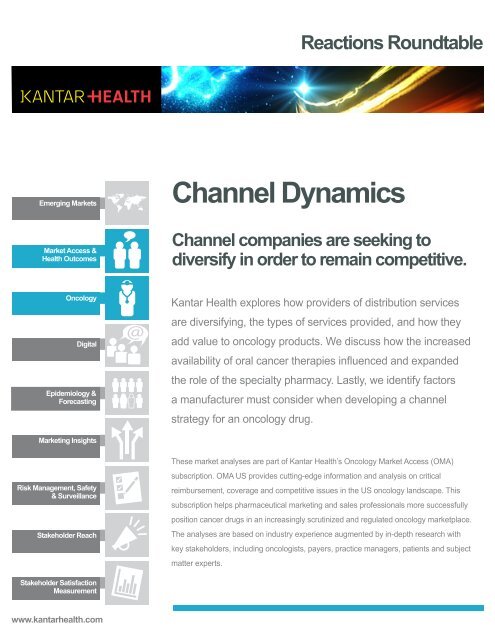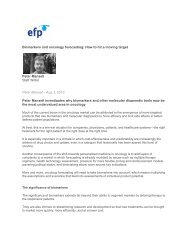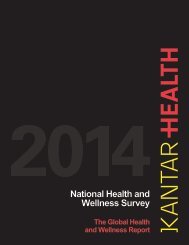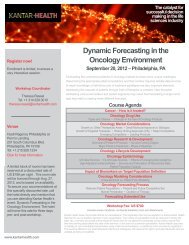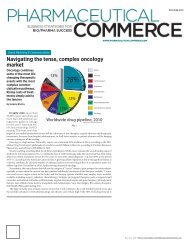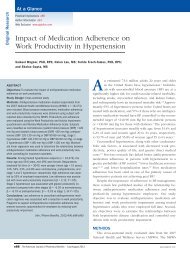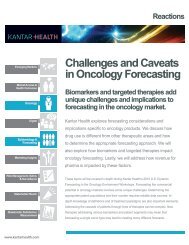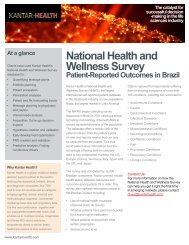Oncology Market Access - Channel Dynamics ... - Kantar Health
Oncology Market Access - Channel Dynamics ... - Kantar Health
Oncology Market Access - Channel Dynamics ... - Kantar Health
You also want an ePaper? Increase the reach of your titles
YUMPU automatically turns print PDFs into web optimized ePapers that Google loves.
Reactions Roundtable<br />
Emerging <strong>Market</strong>s<br />
<strong>Market</strong> <strong>Access</strong> &<br />
<strong>Health</strong> Outcomes<br />
<strong>Channel</strong> <strong>Dynamics</strong><br />
<strong>Channel</strong> companies are seeking to<br />
diversify in order to remain competitive.<br />
<strong>Oncology</strong><br />
Digital<br />
Epidemiology &<br />
Forecasting<br />
<strong>Kantar</strong> <strong>Health</strong> explores how providers of distribution services<br />
are diversifying, the types of services provided, and how they<br />
add value to oncology products. We discuss how the increased<br />
availability of oral cancer therapies influenced and expanded<br />
the role of the specialty pharmacy. Lastly, we identify factors<br />
a manufacturer must consider when developing a channel<br />
strategy for an oncology drug.<br />
<strong>Market</strong>ing Insights<br />
Risk Management, Safety<br />
& Surveillance<br />
Stakeholder Reach<br />
These market analyses are part of <strong>Kantar</strong> <strong>Health</strong>’s <strong>Oncology</strong> <strong>Market</strong> <strong>Access</strong> (OMA)<br />
subscription. OMA US provides cutting-edge information and analysis on critical<br />
reimbursement, coverage and competitive issues in the US oncology landscape. This<br />
subscription helps pharmaceutical marketing and sales professionals more successfully<br />
position cancer drugs in an increasingly scrutinized and regulated oncology marketplace.<br />
The analyses are based on industry experience augmented by in-depth research with<br />
key stakeholders, including oncologists, payers, practice managers, patients and subject<br />
matter experts.<br />
Stakeholder Satisfaction<br />
Measurement<br />
www.kantarhealth.com
Reactions Roundtable<br />
About the Experts<br />
Mark Looman<br />
Analyst, Commercial<br />
Development<br />
Mr. Looman is responsible for analysis and<br />
authorship of OMA US subscription materials<br />
as well as responding to client inquiries and<br />
supporting custom engagements. Mr. Looman<br />
has co-authored peer-reviewed publications on<br />
the burden of illness and developed financial<br />
models, including budget impact models.<br />
He has a depth of expertise in healthcare<br />
coding systems and the Medicare inpatient<br />
reimbursement system.<br />
Question 1: Providers of distribution<br />
services for oncology drugs are<br />
diversifying. What are the types of<br />
services now provided by channel<br />
partners, and how do they add value<br />
to the product?<br />
<strong>Kantar</strong> <strong>Health</strong>’s <strong>Channel</strong> <strong>Dynamics</strong> module<br />
explores channel companies as the<br />
“middlemen” in the industry. They touch many<br />
of the major stakeholders and use these touch<br />
points to gain market share and power by<br />
moving product and providing increasingly<br />
valuable services. The core of what they<br />
offer is access to specialty drugs for a large<br />
base of providers who provide and administer<br />
these drugs (i.e., market share); the rest of<br />
their services build off this foundation and are<br />
proving highly important to the stakeholders.<br />
Consolidation in the specialty distributors (SD)<br />
market has left a few companies with a lot of<br />
power and a need to differentiate themselves.<br />
Product distribution is a low-margin<br />
commodity; services aimed at physicians<br />
secure distribution market share, but services<br />
targeted at payers and manufacturers are more<br />
profitable. Distributors have different strategies,<br />
so familiarity with the organizations is important<br />
for knowing how to leverage their services or<br />
for identifying potential issues.<br />
Although their core business is to distribute<br />
specialty drugs, SDs provide a wide range of<br />
services targeted toward specific stakeholders<br />
that they serve. SDs can offer payers ways to<br />
control spending on specialty drugs and act as<br />
a conduit of information between payers and<br />
providers; they can offer oncologists practice<br />
services, including electronic health records<br />
Figure 1: <strong>Channel</strong> companies interact directly with providers,<br />
payers and patients in the oncology care landscape<br />
Gordon Gochenauer<br />
Director, Commercial<br />
Development<br />
Mr. Gochenauer brings extensive experience<br />
in current treatment trends and assessments<br />
of the future treatment evolution for 30+ cancer<br />
types. His in-depth understanding of numerous<br />
clinical development programs combined with<br />
lessons learned from pricing, coverage and<br />
reimbursement and patient assistance programs<br />
make him uniquely qualified to help clients<br />
make important commercial development<br />
decisions. Mr. Gochenauer has authored a<br />
variety of oncology reports and is recognized as<br />
a market expert for both the US and Japanese<br />
markets.<br />
www.kantarhealth.com
Reactions Roundtable<br />
Specialty distributors are<br />
evolving their business<br />
models to remain<br />
competitive and relevant.<br />
(EHR), inventory management services and<br />
practice workflow and financial management<br />
software, as well as access to their group<br />
purchasing organizations (GPOs) to obtain<br />
discounts on drugs; and they can offer<br />
manufacturers data and consulting for their<br />
products throughout their lifecycle, including<br />
reimbursement and product launch strategies,<br />
hub services, REMS operations and product<br />
marketing.<br />
Manufacturers should keep abreast of practice<br />
management solutions offered by SDs with<br />
the goal of understanding how they affect<br />
prescribing and whether and to what degree<br />
they tilt the balance of power toward the SDs<br />
and away from the manufacturers.<br />
Question 2: How has the increased<br />
availability of oral cancer therapies<br />
influenced or expanded the role of<br />
the specialty pharmacy?<br />
Specialty pharmacies (SPs) are commanding<br />
increased attention as oral therapy is more<br />
common and accepted. Physicians have become<br />
more willing to prescribe oral therapy despite<br />
no financial incentive to their practice—in part<br />
because of the services offered by SPs. Just<br />
two years ago, 60% of oncologists preferred<br />
to prescribe an IV drug over a therapeutically<br />
equivalent oral option. In 2012 this preference<br />
for IV drugs declined to just over 50% of<br />
oncologists 1 . As additional oral oncolytics become<br />
available and oncologists are prescribing them<br />
more, reliance on SPs is increasingly becoming a<br />
routine part of a practice’s daily business.<br />
Figure 2: % of All US Cancer Patients<br />
Treated with Branded Oral Oncolytics<br />
Figure 3: Expenditures on oral<br />
oncology are skyrocketing despite<br />
modest increases in utilization<br />
Oral <strong>Oncology</strong> Drug Statistics, 2011<br />
% of Total Drug Spend 2.3%<br />
∆ from 2010, Utilization 2.6%<br />
∆ from 2010, Inflation* 8.6%<br />
Source: <strong>Kantar</strong> <strong>Health</strong> CancerMPact ® US Patient Metrics<br />
Available from www.cancermpact.com.<br />
<strong>Access</strong>ed August 2012<br />
∆ from 2010, PMPM 18.6%<br />
*Inflation corresponds to changes in the cost of drugs; Unit<br />
cost inflation was driven almost exclusively by brand name<br />
drugs.<br />
Source: Prime Therapeutics<br />
PMPM = Per member per month<br />
1. <strong>Kantar</strong> <strong>Health</strong>; Oncologist Survey, June 2012<br />
ONC 4.15 If there were two treatments, one oral and one IV, that were essentially equivalent in efficacy and tolerability, would you be more likely to prescribe the oral or IV?<br />
ONC 4.15.1 Thinking back to two years ago, would you be more likely to prescribe the oral or IV for two treatments that were essentially equivalent in efficacy and tolerability?<br />
www.kantarhealth.com
Reactions Roundtable<br />
Specialty pharmacy<br />
services play an<br />
important role in<br />
acceptance of oral<br />
oncology drugs<br />
Payers have also identified SPs as an important<br />
part of caring for their patients; the vast majority<br />
have a closed SP network and a single preferred<br />
SP. Payers use SPs to help control specialty<br />
spend. Improved patient care not only ensures<br />
that patients are being taken care of but also<br />
reduces unnecessary spend on incorrect dosing<br />
and biomarker eligibility, incorrect administration<br />
of patient self-administered medications, and<br />
additional and sometimes emergency care visits<br />
to resolve drug-drug interactions or difficult-totolerate<br />
side effects.<br />
SPs evolved to meet the unique needs<br />
associated with specialty pharmaceuticals. In<br />
fact, SP clinical expertise ultimately defines the<br />
niche that SPs will fill. When a manufacturer is<br />
seeking SP services, it is wise to consider the<br />
SPs that have the most relevant clinical expertise<br />
and experience. For example, an SP with indepth<br />
knowledge of hepatitis or HIV may not be<br />
as well equipped to manage an oncology drug.<br />
Question 3: What are the factors a<br />
manufacturer must consider when<br />
developing a channel strategy for an<br />
oncology drug?<br />
preferred relationships that may result in more<br />
favorable contract terms or better placement in<br />
the SD’s portfolio of drugs, but the burden for<br />
obtaining the drug will be higher than if you have<br />
an open network.<br />
For oral drugs, SPs improve patient compliance<br />
and persistence with their therapy. When<br />
determining an SP network, there are multiple<br />
factors to consider. For example, very small<br />
patient populations can warrant a very limited<br />
SP distribution strategy, while a limited strategy<br />
for large patient populations could result in a<br />
bottleneck for obtaining the drug and cause<br />
issues with higher patient cost-sharing due to<br />
distribution through non-payer-preferred SP.<br />
The nature of the product is also important, as<br />
drugs with few safety risks and uncomplicated<br />
administration could potentially go through the<br />
retail pharmacy segment as well, though prior<br />
authorizations and high cost sharing will likely<br />
remain an access challenge. <strong>Access</strong> to market<br />
data is also important as SPs do not regularly<br />
report this information to data aggregators.<br />
Establishing data submission as part of the SP<br />
contract or working with hub services is important<br />
in order to know how your product is being used<br />
and to identify issues and opportunities.<br />
Manufacturers should incorporate a channel<br />
strategy into their commercialization plans<br />
beginning at least 18 months before launch. It is<br />
necessary to understand the opportunities and<br />
risks of strategic options with both SDs and SPs.<br />
For physician-administered products, the primary<br />
channel will be SDs. As discussed, SDs offer<br />
many services to a number of stakeholders in<br />
the oncology marketplace. This central position<br />
provides a platform to impact prescribing, so<br />
understanding what services can threaten or<br />
improve market access is vital. Beyond the<br />
services provided by SDs, it is important to<br />
think about the size of your distribution network.<br />
Contracting with a few SDs can allow for<br />
For more information,<br />
please email us at:<br />
info@kantarhealth.com<br />
www.kantarhealth.com<br />
Source: <strong>Kantar</strong> <strong>Health</strong>, <strong>Oncology</strong> <strong>Market</strong> <strong>Access</strong> US, <strong>Channel</strong> <strong>Dynamics</strong> module. Available at<br />
www.oncologymarketaccess.com.


